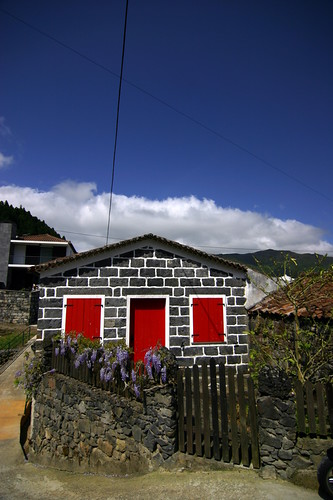It is the fish that abounds off its coasts that holds the place of honour in the cooking of Graciosa, in the form of delicious fish stews and baked parrot fish. The local lobsters and spider-crabs are an exquisite meal in themselves while the smaller crabs and goose barnacles can serve as tasty appetisers.

The focal sweets are rich and varied and include not only cheese-cakes (queijadas) but specialities with such names as encharcados de ovos, capuchas, bolos de junça, cavacas, barrigas, pastéis de arroz, escomilhas and massa sovada, the last mentioned being connected with the Holy Ghost Festivals.
To accompany the meal there is the famous white wine of Graciosa, light, dry and fruity, or then the wine called vinho de cheiro that accompanies all the festivals in the island. The brandy, aged in casks, is an excellent digestive and those who like sweet drinks have the locally produced wine called angelica.
"Biscoitos" vines.
The first settlers came from lands where vine growing was a centuries-old tradition. When they saw the lava beds called biscoitos - sunny and only slightly damp, that covered part of the island, they immediately set to work and by dint of hard work managed to plant there the vine shoots brought from the continent. This marked the birth, in the early 16th century, of the vineyards that cut the landscape up into rectangles of black stone. The phylloxera ravaged the vineyards in the 19th century but the initial verdelho strain was joined by arinto and later by terrantês, which ensured the survival of the vines on the island.

The focal sweets are rich and varied and include not only cheese-cakes (queijadas) but specialities with such names as encharcados de ovos, capuchas, bolos de junça, cavacas, barrigas, pastéis de arroz, escomilhas and massa sovada, the last mentioned being connected with the Holy Ghost Festivals.
To accompany the meal there is the famous white wine of Graciosa, light, dry and fruity, or then the wine called vinho de cheiro that accompanies all the festivals in the island. The brandy, aged in casks, is an excellent digestive and those who like sweet drinks have the locally produced wine called angelica.
"Biscoitos" vines.
The first settlers came from lands where vine growing was a centuries-old tradition. When they saw the lava beds called biscoitos - sunny and only slightly damp, that covered part of the island, they immediately set to work and by dint of hard work managed to plant there the vine shoots brought from the continent. This marked the birth, in the early 16th century, of the vineyards that cut the landscape up into rectangles of black stone. The phylloxera ravaged the vineyards in the 19th century but the initial verdelho strain was joined by arinto and later by terrantês, which ensured the survival of the vines on the island.




















